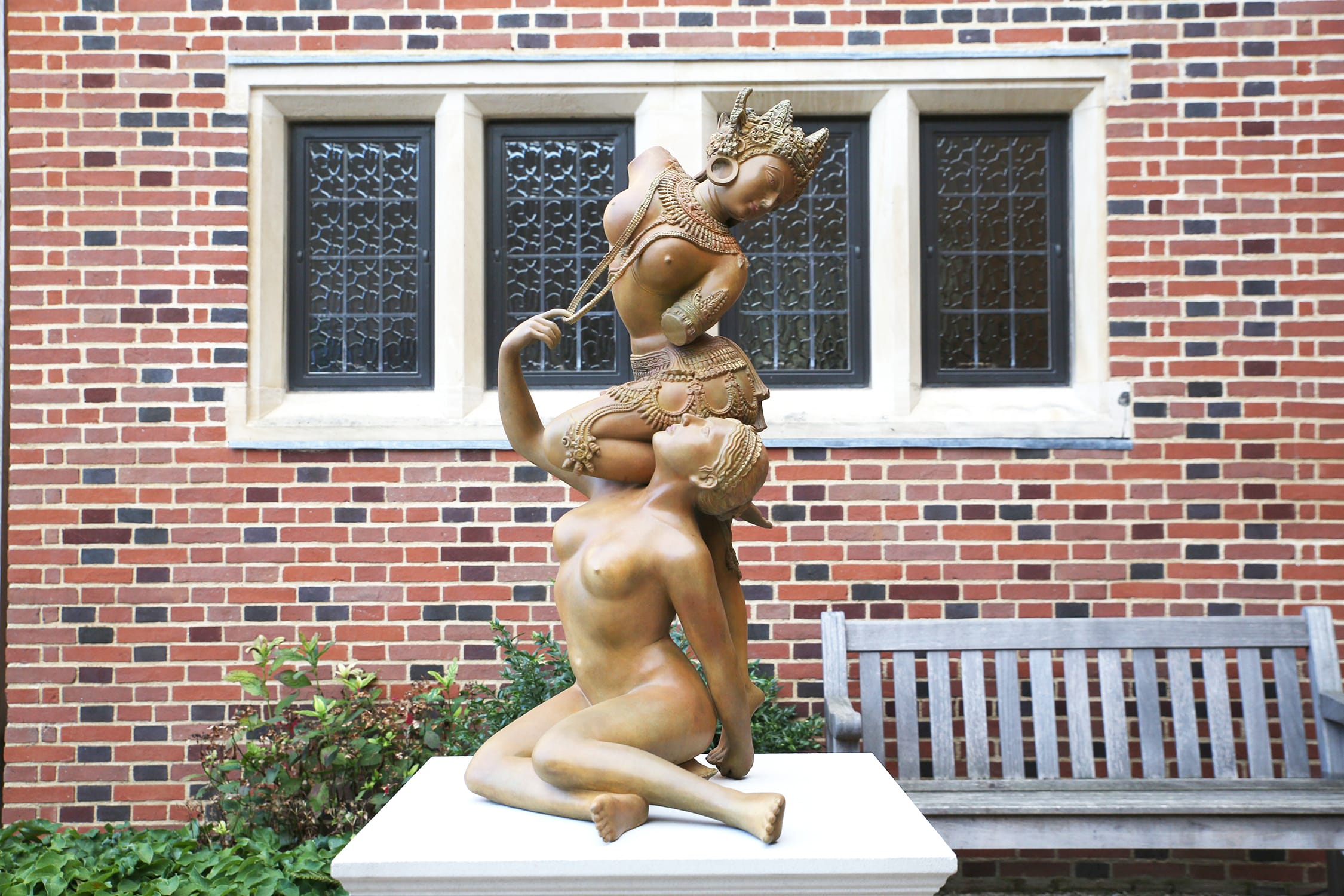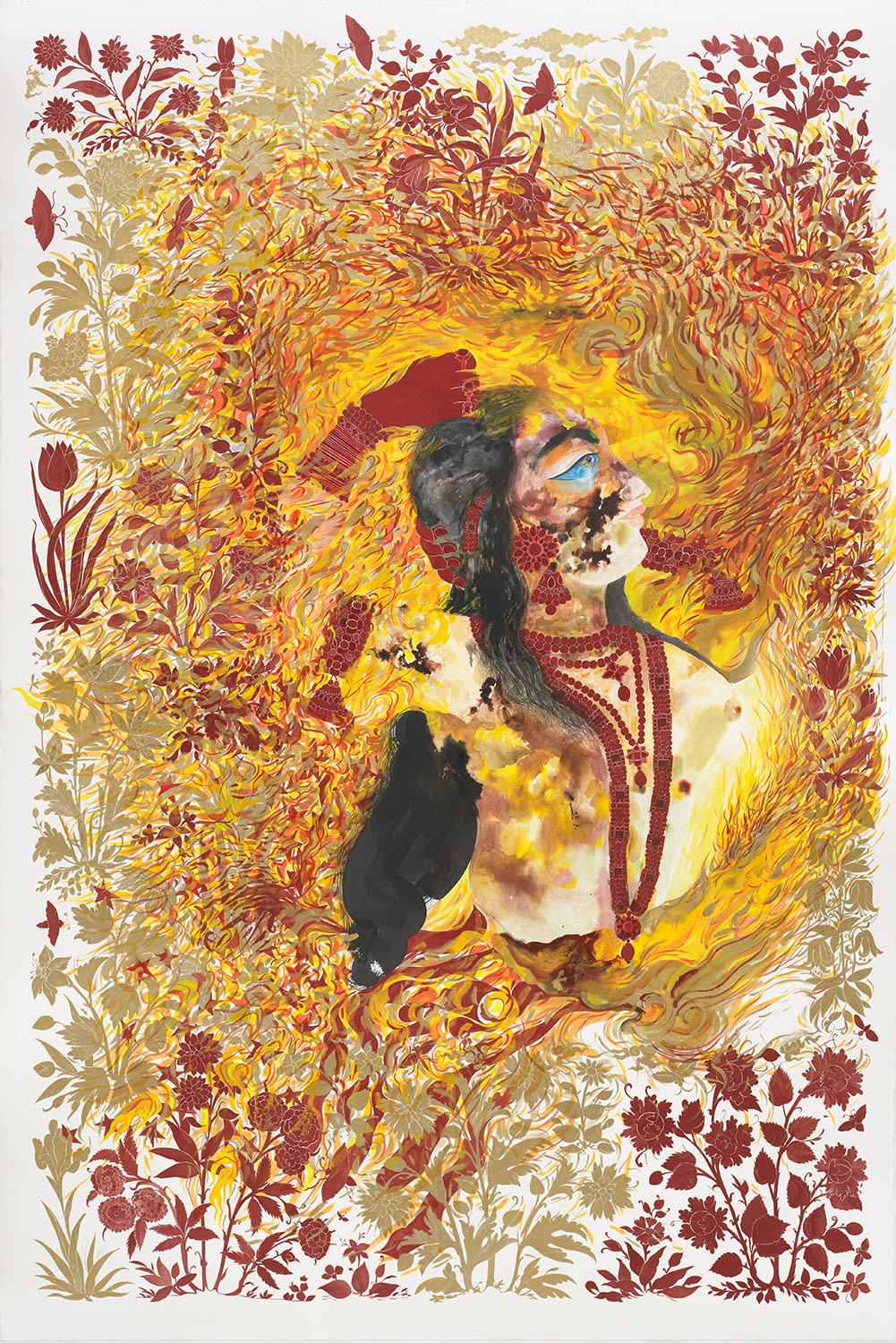Inside the Museum of Fine Arts in Houston, Texas, presiding over the recently opened exhibition ‘Extraordinary Realities’, like a quiet sentinel, stands the bronze sculpture Promiscuous Intimacies (2020) by the artist Shahzia Sikander. It features two patinated figures perched on a plinth at eye level: a seated Venus in the Greco-Roman style, looking upward at a limbless Indian Devata, whose bent knee rests upon the other’s shoulder. A finger rises to tug at the deity’s necklace, and their gazes interlock, seemingly impervious to outside eyes, conveying an implicit desire made only for them.

When it was first shown in her debut exhibition, ‘Weeping Willows, Liquid Tongues’, at Sean Kelly in New York, in November 2020, many viewers noted the originality of the work. It was seen as an unexpected first foray into sculpture by Pakistan-born Sikander, an artist celebrated primarily for her radical, feminist take on the intricate art of Indo-Persian manuscript painting, and her development of a style known as ‘neo-miniature’. Miniatures at the time of the Mughal Empire captured everyday life in the court or battle scenes in minute detail. Sikander draws upon the conventions of the art form to beautifully bridge personal and political subject matter, from her experiences as a Muslim woman to speculations about the spike of nationalist sentiment in the wake of 9/11. In doing so, she puts forward potent critiques that question the legitimacy of ingrained ideas about tradition, culture, nation, and gender.
In truth, the sculpture was really Sikander doing what she had done all along. On a recent phone call from New York, where she now lives, she described this as ‘thinking and rethinking, and finding shifting lenses’, adding, ‘the thread of the female runs very deeply in the work’. Right now, Sikander is working on her second sculpture, to be shown in Madison Square Park in 2023.
Promiscuous Intimacies is the impressive outcome of numerous reinterpretations of the same motif, conceptualized by Sikander while working on the catalog for ‘Extraordinary Realities’ – an illuminating survey of the first 15 prolific years of her career. This exhibition, now at its final stop in Houston, originated at the Morgan Library in New York in June 2021, before moving onto the Rhode Island School of Design, where Sikander received her MFA in 1995. During this period, Sikander was in regular conversation with the scholar Gayatri Gopinath, Director of the Center for the Study of Gender and Sexuality at New York University. Gopinath contributed an essay to the book titled Promiscuous Intimacies: Embodiment, Desire, and Diasporic Dislocation in the Art of Shahzia Sikander. The sculpture borrows its name from the text, which offers an insightful reading of Sikander’s early works on paper through a queer optic.

Trained at the National College of Arts in Lahore at a time when the laborious technique was maligned as kitsch, Sikander sensed its potential for new expression. ‘It’s a very detailed, very slow process, so my mind was always running faster than the actual act of creating that type of work,’ she says. ‘I intuitively realized it was ripe for deconstruction.’ She began incorporating feminine forms into her paintings while honoring the hallmarks of the genre – delicately brushing her watercolors onto wasli paper, the same used by artists of the Mughal period, and giving them a yellow wash with tea. She received media attention in Pakistan for her graduation work, The Scroll (1989–1990), which was awarded the school’s highest honor of achievement, the Shakir Ali award. The work features a ghostly, at times transparent, figure in a white dress in various domestic scenes within a sprawling family residence. The setting is based on Sikander’s childhood home.
As Sikander experimented and developed her practice in the years that followed, her figures became increasingly fantastical, even grotesque, merging with monsters and monkeys, growing appendages to create hybrids which were upturned, dismembered, and infinitely layered. In the collage-like Pleasure Pillars (2001), the artist’s self-portrait sprouts spiraling ram’s horns, while court dancers in profile seem to flit around the edges of the page. As Gopinath writes, ‘This queer optic brings to the fore precisely the promiscuous intimacies of multiple times, spaces, art-historical traditions, bodies, desires, and subjectivities; it allows us to glimpse other worlds not beholden to the here and now of gender and sexual normativity.’
Gopinath and Sikander had crossed paths before, navigating overlapping social circles in the late 1990s as the artist was gaining recognition alongside others like Kara Walker and Teresita Fernández; the catalog offered an exciting opportunity to reconnect. Sikander felt inspired by this fresh perspective on her work, especially as a counter to narratives that emerged early in her career, that burdened her practice with othering assumptions about identity or nation – constructs of which she is bitingly critical. ‘It’s imagined that, because it's in Asia, you're learning ancient craft,’ she says. ‘What is so ancient about gouache and watercolor?’ Sikander revisited one of the subjects of their discussions, a small but generative drawing called Intimacy (2001), which she hadn’t seen in 20 years.
This intricate image centers on two characters, including a nearly invisible divine entity modeled after a sculpture at the Metropolitan Museum of Art in New York. The being is entangled with a lounging nude, lifted from the painting An Allegory with Venus and Cupid (c. 1545), by Italian mannerist Bronzino. Neat rows of green and white circles flank the figures; this is emblematic of a seriality integral to Sikander’s work, which has meant that it frequently lends itself to animation – an earlier revisit to this piece inspired her first experiments in video while in residence at Artpace in San Antonio, Texas. For its sculptural update, Sikander photographed two models, a friend and a professional dancer, who recreated the pose. From those pictures, a cast was made. Sikander’s manner of working is often circular in this way, reexamining her own archive to discover something in the interstitial and the transitory, while pulling from a familiar visual vernacular.
Sikander describes herself as a ‘detective’, investigating her own pieces with the same fervor as she does artifacts in institutional collections, whose murky acquisitions often obscure violent histories. ‘Looking back at my own work, I have had that same relationship as when I look at historical paintings,’ she says. ‘I'm perusing them for ideas and their moment in time.’ She draws daily and reads concurrently, a routine that gives way to transformative ideas. Works in her exhibition ‘Infinite Woman’ at Pilar Corrias in London in 2021 came about through reading the American writer Adrienne Rich, who translated the Indian poet Ghalib and thus wrote in the Urdu ghazal form of lyrical poetry. In this way, too, her work is promiscuous: always in conversation, in development, in transit. ‘When I'm reading like this, it gives me an armature of thinking,’ she says, ‘and then some ideas will crystallize into forms.’
Coco Romack is a writer, editor, and author based in New York.
‘Extraordinary Realities’ is on view at the Museum of Fine Arts, Houston, through June 5, 2022. Shahzia Sikander is represented by Sean Kelly, New York, and Pilar Corrias, London.
Discover more related content below:
Captions for full-bleed images, from top to bottom: 1. Shahzia Sikander, Infinite Woman (detail), 2021. Courtesy of the artist and Pilar Corrias, London. Note: A dark filter has been applied over this image. 2. Shahzia Sikander. Courtesy of the artist and Pilar Corrias, London. 3–4. Shahzia Sikander, The Scroll (detail), 1989–1990. Courtesy of the artist; Sean Kelly, New York; and Pilar Corrias, London.